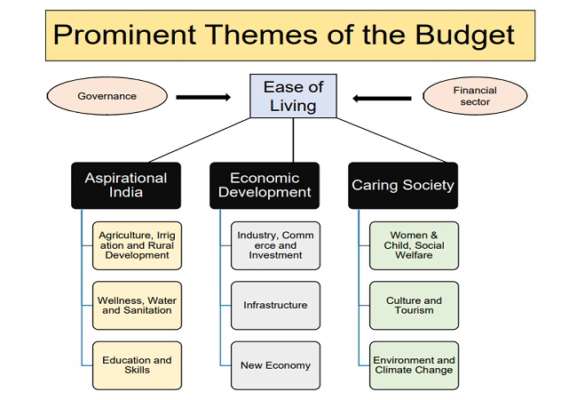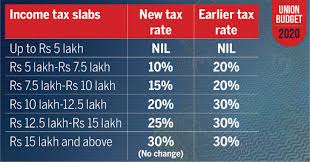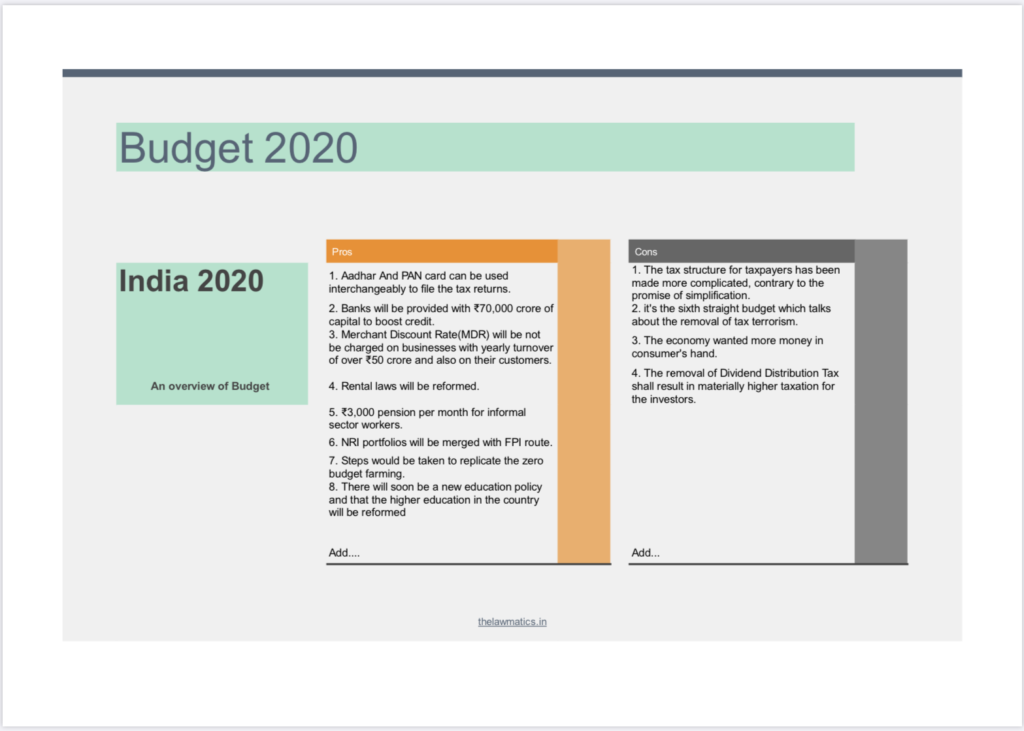By: Prerna Piplani
REVIEW ON UNION BUDGET 2020-21
BACKGROUND:
The union budget of India, also referred to as the Annual Financial Statement in the Article 112 of the Constitution of India, is the annual budget of the republic of India. The Government presents it on the 1st day of February so that it could be materialised before the beginning of new financial year in April. Until 2016 it was presented on the last working day of February by the finance minister in parliament.
The budget, which is presented by means of the finance bill and appropriation bill has to be passed by lok sabha before it can come into effect on 1st April, the start of India’s financial year. India’s first budget was presented on 18th February 1860. R.K.Shanmukham Chetty, the first finance minister of independent India presented the Union budget on 26th November 1947.
As of September 2019, Morarji Desai has presented 10 budgets which is the highest count followed by P.Chitambaram’s 9 and Pranab Mukherjee’s 8. As a part of tradition, Finance ministers carried the budget in leather briefcase. The tradition was Established by India’s first finance minister. On 5th July 2019, Nirmala Sitaraman broke this tradition by carrying the budget in a Bahi-khata.
INTRODUCTION:
Our finance minister Nirmala Sitaraman presented the Union budget for the year 2020-2021 on 1st February, 2020.She delivered the longest budget speech ever by finance minister.
Notably, she read out a kashmiri poem during the budget speech in the parliament as well as a Tamil couplet written by Thiruvalluvar. Central ideas of the budget are : “aspirational India, economic development, a caring society.”
UNION BUDGET 2020-21:
This year the prominent theme of the budget focuses on the “Ease of living.”

1. DIGITAL REVOLUTION-
• Digital governance
• Improve physical quality of life through national infrastructure pipeline
• Disaster resilience
• Social security through pension and insurance penetration.
2. FINANCIAL SECTOR-
• Bank deposit insurance coverage has been increased from ₹1 lakh to ₹5 lakh.
• Government plans to amend the companies act to decriminalize civil offences.
• 5 trillion dollar target to be achieved by 2024 in GDP.
• Government to sell part of its stake in LIC via public offering.
3. TAXATION-

• A new tax regime has been announced. Those who want to be in the old regime with exemptions, can continue.
• Over 70 deductions have been removed.
• Companies will no longer be required to pay dividend distribution tax(DDT).
4. AGRICULTURE-
• A budget allocation of ₹2.83 lakh crore for the sector comprising agriculture and allied activities.
• Provide 20 lakh farmers to set up standalone solar pumps. Help another 15 lakh farmers to solarise their power grid.
• Agri- credit availability set at 15 lakh crore for 2020-21.
5. HEALTH AND SANITATION-
• An allocation of ₹69,000 crore for the health sector.
• ₹12,300 crore for Swachh Bharat Mission this year.
• Proposals to setup hospitals in Tier-II and Tier-III cities with the private sector using PPP.
6. EDUCATION-
• ₹99,300 crore for education sector in 2021 and about ₹3000 crore for skill development.
• Urban local bodies to provide internship to young engineers for a year.
• Degree level full-Fledged online courses by institutions top ranked by NIRF, especially to benefit underprivileged students.
7. INFRASTRUCTURE-
• Proposal to provide ₹1.7 lakh crore for transport infrastructure in 2021.
• Chennai- Bengaluru Expressway and Bengaluru suburban rail project to be started.
• Aim to achieve electrification of 27,000 km of lines.
Budget Expenditure for this year is ₹30,42,230 crores
The Indian Budget 2020 is of ₹30.42 lakh crore rupees. The expenditure has increased significantly when compared with the Union Budget 2019, where the expenditure figure was ₹26.98 lakh crore rupees (revised estimates).
Total Receipts (without considering borrowing): Only ₹22,45,893 crores
The total revenue expected in the financial year 2020-21(without considering borrowing) is only ₹22.45 lakh crores. As you can see the expenditure (₹30.42 lakh crores) is way higher than the receipts (₹22.45 lakh crores).
To balance the expenditure and receipts side of the budget, the government needs to borrow money.
The Tax Revenue Split:
Income Tax is still expected to generate 17% of total receipts. A greater share (18%) is expected from Corporation Tax. Another 18% of receipts is estimated from the major indirect tax – Goods and Service Tax (GST). However, the major share of receipts in Budget 2020 comes from borrowings and other liabilities (20%).
Conclusion:
One important clue from this year budget is the falling tax revenue. Even the government has lowered its expectations on tax-revenue when compared to last year. Tax-revenue along with non-tax revenue is only helping to meet 2/3rd of the expenditure.
As the economy is facing a slowdown, the government cannot expect much from the income tax. GST still has many bottlenecks to be fixed.

To get out of the current economic slowdown, increase in fiscal spending in the priority areas is the right solution.
To conclude, while the vision of the budget is good, the logic of the division of funds under various heads could have been better.
Author: Prerna Piplani(Panjab University,Dept of Law)
This article is really helpful.